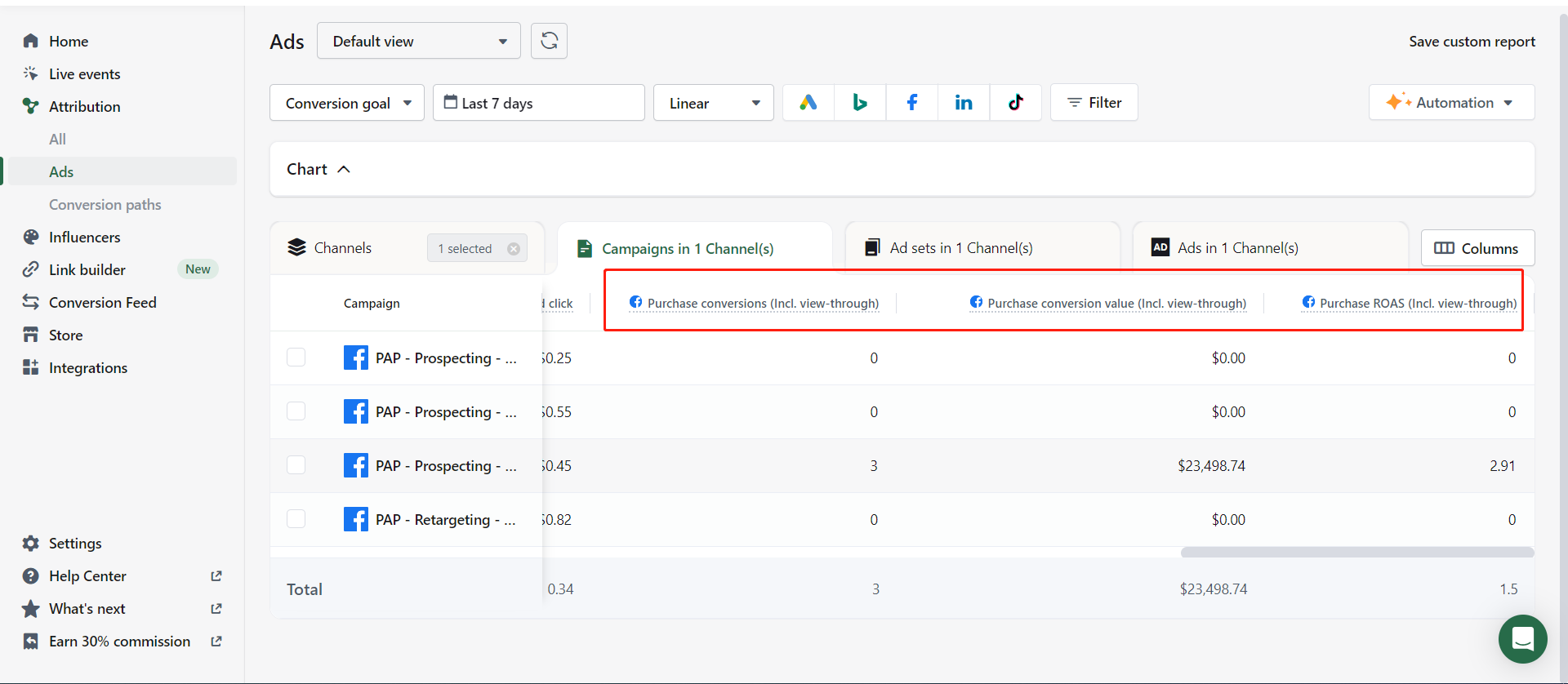What is View-Through Attribution? A Guide for eCom Marketers

Introduction to View-Through Attribution

Not every customer clicks on an ad — but that doesn’t mean the ad didn’t influence their purchase. View-through attribution helps ecommerce marketers measure the hidden impact of ad impressions that lead to conversions later. In this guide, you’ll learn what view-through attribution means, how it compares to click-based tracking, and how to apply it effectively in your Shopify or DTC ad strategy.
Definition of View-Through Attribution
View-through attribution is a marketing measurement technique that assigns value to ads based on views, not just clicks. Traditionally, click-based attribution was the primary method used to measure ad effectiveness. However, this approach failed to capture the impact of ads that were viewed but not clicked on. This will leave a lot of money on your table. View-through attribution fills this gap by considering the influence of ad views in driving conversions.
Origin and Evolution of View-Through Attribution
View-through attribution originated as a way to measure the effectiveness of display advertising. Advertisers wanted to understand if display ads had an impact on brand awareness and purchase intent, even if users did not click on them. As technology advanced, view-through attribution expanded beyond display ads and encompassed other ad formats and channels such as social media and video advertising.
The evolution of view-through attribution has been driven by the need for more comprehensive marketing measurement. Marketers recognized that clicks alone do not provide a complete picture of ad performance. Customers often engage with multiple touchpoints before making a purchase decision, and view-through attribution acknowledges the role played by non-click interactions in influencing conversions.
By incorporating view-through attribution into their marketing strategies, eCommerce businesses gain valuable insights into the true impact of their ads. They can accurately measure how many conversions were influenced by ad views rather than just clicks, providing a more holistic understanding of campaign performance.
Furthermore, view-through attribution allows marketers to optimize their ad placements based on view-through conversions. By identifying the placements that generate the most view-through conversions, businesses can allocate their advertising budget more effectively and drive better results.
In summary, view-through attribution is a powerful marketing measurement technique that assigns value to ads based on views. It has evolved from its origins in display advertising to encompass various ad formats and channels. By incorporating view-through attribution into their strategies, eCommerce businesses can gain a deeper understanding of their ad performance and optimize their marketing efforts for maximum impact. In the next section, we will explore how to utilize view-through attribution in eCommerce marketing.
Utilizing View-Through Attribution in eCommerce Marketing
View-through attribution is a powerful marketing measurement technique that can greatly benefit eCommerce businesses, especially those operating on platforms like Shopify. By understanding how to utilize view-through attribution effectively, marketers can optimize their ad placements, determine the overall performance of their campaigns, and attribute value to ads that contribute to conversions indirectly.
One of the key applications of view-through attribution in eCommerce marketing is measuring the impact of display ads on brand awareness. Traditionally, display advertising has been considered more effective for brand building rather than driving direct conversions. However, with view-through attribution, marketers can now assign value to display ads based on the number of times they are viewed, even if no click occurs. This allows them to gain insights into how these ads are influencing brand awareness and perception among their target audience.
Another way eCommerce businesses can benefit from view-through attribution is by optimizing ad placements based on view-through conversions. View-through conversions refer to instances where a user sees an ad but doesn't click on it, yet later converts or makes a purchase. By analyzing data from view-through conversions, marketers can identify which ad placements or channels are generating the most indirect conversions and adjust their strategies accordingly. For example, if they find that certain websites or social media platforms consistently drive high view-through conversions, they can allocate more budget towards those channels to maximize their return on investment.
Determining the overall performance of a marketing campaign is another crucial aspect of utilizing view-through attribution in eCommerce marketing. Instead of solely relying on click-based metrics like click-through rates or cost per click, marketers can now take into account the views generated by their ads as well. This provides a more comprehensive picture of how well their campaigns are performing and helps them make informed decisions about future ad spend allocation.
Furthermore, view-through attribution allows marketers to attribute value to ads that contribute to conversions indirectly. In many cases, customers may be exposed to multiple touchpoints along their purchasing journey before making a final decision. View-through attribution recognizes the role of ads that may not directly lead to a click or immediate conversion but still play a significant part in influencing the customer's decision-making process. By assigning value to these ads, marketers can better understand their impact and allocate resources accordingly.
Key Features of View-Through Attribution
View-through attribution offers several key features that make it a valuable tool for Shopify marketers. By assigning value to ads based on views, not just clicks, businesses can gain a more comprehensive understanding of the impact of their advertising efforts. Additionally, setting view-through conversion windows and integrating view-through attribution with click-based attribution provide further insights into the customer journey and optimize marketing strategies.
Assigning value to ads based on views, not just clicks
One of the key features of view-through attribution is its ability to assign value to ads based on views, rather than solely focusing on clicks. This means that even if a user does not click on an ad, but simply views it, the ad can still be credited with contributing to conversions. Facebook provides this metric for Shopify merchants, allowing them to measure the effectiveness of their display advertising campaigns.
By considering both views and clicks in attributing value to ads, businesses can gain a more accurate understanding of how their ads are influencing consumer behavior. This holistic approach takes into account the impact of brand exposure through ad views and recognizes that conversions can be influenced by multiple touchpoints along the customer journey.
In addition to assigning value to ads based on views, view-through conversions (VTC) and return on ad spend (ROAS) are important metrics that can be tracked through view-through attribution. VTC refers to conversions that occur after a user has viewed an ad but did not click on it. ROAS measures the revenue generated from advertising spend and allows businesses to assess the overall performance and profitability of their marketing campaigns.
Setting view-through conversion windows
Another key feature of view-through attribution is the ability to set conversion windows for tracking ad views. A conversion window determines how long after viewing an ad a conversion can be attributed to that specific ad impression. For example, if a business sets a 1-day view-through conversion window, any conversions that occur within 24 hours of an ad view will be credited to that ad.
Setting the appropriate conversion window is crucial in accurately attributing conversions to ads. It allows businesses to account for delayed conversions and understand the long-term impact of their advertising efforts. Facebook, for instance, offers a 1-day view-through conversion window, giving marketers the flexibility to assess the effectiveness of their ads within a specific timeframe. Attribuly currrently also offers 1-day conversion window.
By setting conversion windows, businesses can gain insights into how different ads perform over time and optimize their ad placements accordingly. This feature enables them to identify which ads are most effective in driving conversions and make data-driven decisions about their advertising strategies.
Integrating view-through attribution with click-based attribution
View-through attribution can also be integrated with click-based attribution models, such as last-click or first-click attribution. Click-based attribution focuses on attributing conversions solely to the last or first click that led to a conversion. By combining both view-through and click-based attribution models, businesses can gain a more comprehensive understanding of the customer journey and the role each touchpoint plays in driving conversions.
Integrating these two attribution models allows businesses to analyze the entire customer journey from initial exposure through ad views to final conversion through clicks. This integration provides valuable insights into how different marketing channels and touchpoints work together to influence consumer behavior.
For example, if a user sees an ad but does not click on it initially, but later converts after clicking on another ad or organic search result, both view-through and click-based attributions can be considered in attributing value to those ads. This comprehensive analysis helps businesses allocate their marketing budgets effectively and optimize their advertising strategies based on a holistic understanding of the customer journey.
If the Attribuly Pixel ROAS was 3, and Facebook's view-through attribution claimed an additional 0.5 ROAS, then toggling to the Attribuly Attribution + FB Views model will plus that additional 0.5 ROAS, which is 3+0.5=3.5.
Future Trends in View-Through Attribution
As technology continues to advance and consumer behavior evolves, the field of view-through attribution is also expected to undergo significant changes. Here are some future trends that we can anticipate in this area:
Increased focus on cross-device view-through attribution: With the proliferation of smartphones, tablets, and other connected devices, consumers are now engaging with ads across multiple platforms. As a result, there will be a growing need for cross-device view-through attribution to accurately measure the impact of ads viewed on different devices. This will enable marketers to gain a more comprehensive understanding of their customers' journey and optimize their advertising strategies accordingly.
Integration of view-through attribution with offline channels: While online advertising has become increasingly dominant, offline channels such as television and print media still play a significant role in reaching consumers. In the future, we can expect to see greater integration between view-through attribution and offline channels. This will allow marketers to measure the effectiveness of their offline advertising efforts and gain insights into how these channels contribute to overall conversions.
Improved measurement of viewability and ad exposure time: Viewability refers to whether an ad is actually seen by users. Ad exposure time measures how long users are exposed to an ad. Both metrics are crucial for accurate view-through attribution. In the future, advancements in technology will enable more precise measurement of viewability and ad exposure time. This will provide marketers with better data to evaluate the true impact of their ads and make informed decisions about their advertising strategies.
Advanced machine learning algorithms for more accurate attribution: Machine learning algorithms have already revolutionized many aspects of marketing analytics. In the context of view-through attribution, machine learning can help improve accuracy by analyzing vast amounts of data and identifying patterns that humans may overlook. By leveraging machine learning algorithms, marketers can expect more reliable and precise attribution models that take into account various factors influencing conversions.
In conclusion, as e-commerce businesses continue to rely on digital advertising for growth, view-through attribution will play a crucial role in measuring the effectiveness of their marketing efforts. By assigning value to ads based on views, not just clicks, businesses can gain a more holistic understanding of their customers' journey and optimize their advertising strategies accordingly. Furthermore, future trends such as cross-device attribution, integration with offline channels, improved measurement of viewability and ad exposure time, and advanced machine learning algorithms will further enhance the accuracy and effectiveness of view-through attribution. As technology continues to evolve, it is essential for e-commerce marketers to stay updated with these trends and leverage them to drive better results for their businesses.